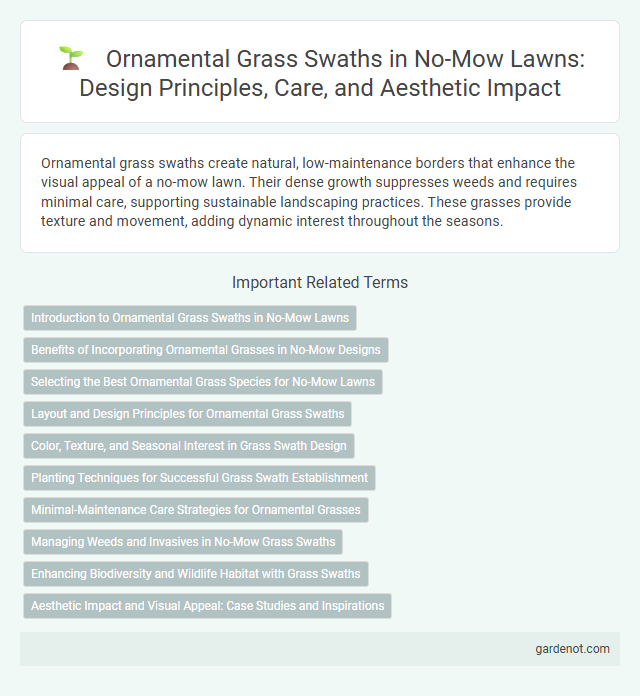Ornamental grass swaths create natural, low-maintenance borders that enhance the visual appeal of a no-mow lawn. Their dense growth suppresses weeds and requires minimal care, supporting sustainable landscaping practices. These grasses provide texture and movement, adding dynamic interest throughout the seasons.
Introduction to Ornamental Grass Swaths in No-Mow Lawns
Ornamental grass swaths enhance no-mow lawns by providing low-maintenance, drought-tolerant greenery that requires minimal trimming. These grasses, such as feather reed grass and blue oat grass, create textured layers and seasonal color variations, offering visual interest year-round. Incorporating ornamental grass swaths improves biodiversity and soil health, supporting a sustainable landscape.
Benefits of Incorporating Ornamental Grasses in No-Mow Designs
Ornamental grasses in no-mow lawn designs enhance biodiversity by providing habitat and food for pollinators and wildlife while reducing maintenance needs. Their deep root systems improve soil health and water retention, contributing to sustainable landscaping. These grasses offer year-round visual interest through varied textures, colors, and seasonal movement, increasing aesthetic appeal without frequent mowing.
Selecting the Best Ornamental Grass Species for No-Mow Lawns
Selecting the best ornamental grass species for no-mow lawns involves prioritizing drought-tolerant, low-maintenance varieties like Blue Fescue, Feather Reed Grass, and Fountain Grass. These species thrive without frequent cutting, provide year-round visual interest with their diverse textures and colors, and support local wildlife by offering habitat and food sources. Incorporating native ornamental grasses further enhances sustainability and reduces water usage in no-mow lawn designs.
Layout and Design Principles for Ornamental Grass Swaths
Ornamental grass swaths enhance garden aesthetics by introducing texture and movement, requiring careful layout to balance visual flow and spatial harmony. Design principles emphasize grouping grasses of varying heights and densities to create dynamic layers, avoid monotony, and ensure seasonal interest. Strategic placement along pathways or borders maximizes impact while facilitating maintenance and promoting healthy growth.
Color, Texture, and Seasonal Interest in Grass Swath Design
Ornamental grass swaths enhance no-mow lawns by delivering vibrant color variations from deep green to golden hues, offering multi-seasonal appeal. Textures range from fine blades to feathery plumes, creating dynamic visual and tactile contrasts. Seasonal interest intensifies as grasses transition through fresh spring growth, summer fullness, and striking winter seed heads, enriching landscape diversity year-round.
Planting Techniques for Successful Grass Swath Establishment
Successful establishment of an ornamental grass swath requires selecting well-drained soil and planting during early spring or fall for optimal root development. Space plants adequately, typically 12 to 18 inches apart, to promote airflow and prevent disease. Consistent watering during the initial growth phase and applying a balanced fertilizer support vigorous, resilient grass swath growth in a no-mow lawn.
Minimal-Maintenance Care Strategies for Ornamental Grasses
Ornamental grass swaths thrive with minimal-maintenance care strategies such as applying a 2-3 inch layer of organic mulch to retain moisture and suppress weeds, reducing the need for frequent mowing. Deep, infrequent watering promotes deep root growth, enhancing drought tolerance and overall resilience. Pruning ornamental grasses once a year in late winter or early spring encourages healthy new growth while maintaining their aesthetic appeal.
Managing Weeds and Invasives in No-Mow Grass Swaths
Managing weeds and invasives in no-mow ornamental grass swaths requires targeted removal techniques such as hand-pulling or spot herbicide treatments to preserve native species and maintain biodiversity. Regular monitoring during early growth stages helps identify invasive seedlings before they establish dominance. Incorporating dense native grass varieties enhances competitive exclusion, reducing opportunities for weed colonization in no-mow landscapes.
Enhancing Biodiversity and Wildlife Habitat with Grass Swaths
Ornamental grass swaths create diverse habitats that support pollinators, birds, and beneficial insects, significantly enhancing local biodiversity. These no-mow zones reduce soil erosion and improve soil health by fostering deep root systems in native grasses. Integrating grass swaths into landscaping promotes ecological balance and provides essential resources for urban and suburban wildlife populations.
Aesthetic Impact and Visual Appeal: Case Studies and Inspirations
Ornamental grass swaths transform no-mow lawns by introducing dynamic textures and shifting hues that enhance aesthetic impact while reducing maintenance. Case studies reveal how species like Miscanthus sinensis and Pennisetum alopecuroides create seasonal interest with their flowing plumes and vibrant color changes, elevating visual appeal in residential and commercial landscapes. Inspirations from botanical gardens highlight strategic grouping and layering techniques, maximizing depth and focal points without the need for traditional mowing.
Ornamental grass swath Infographic

 gardenot.com
gardenot.com